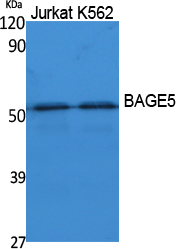产品名称
BAGE5 Rabbit Polyclonal Antibody
别名
BAG5; KIAA0873; BAG family molecular chaperone regulator 5; BAG-5; Bcl-2-associated athanogene 5
蛋白名称
BAG family molecular chaperone regulator 5
存储缓冲液
Liquid in PBS containing 50% glycerol, 0.5% BSA and 0.02% New type preservative N.
Human Gene Link
http://www.ncbi.nlm.nih.gov/sites/entrez?db=gene&term=9529
Human Swissprot No.
Q9UL15
Human Swissprot Link
http://www.uniprot.org/uniprotkb/Q9UL15/entry
Mouse Gene Link
http://www.ncbi.nlm.nih.gov/sites/entrez?db=gene&term=70369
Mouse Swissprot No.
Q8CI32
Mouse Swissprot Link
http://www.uniprot.org/uniprot/Q8CI32
Rat Gene Link
http://www.ncbi.nlm.nih.gov/sites/entrez?db=gene&term=366734
Rat Swissprot Link
http://www.uniprot.org/uniprot/Q5QJC9
免疫原
Synthesized peptide derived from BAGE5 . at AA range: 30-110
特异性
BAGE5 Polyclonal Antibody detects endogenous levels of BAGE5 protein.
稀释度
WB 1:500 - 1:2000. ELISA: 1:5000. Not yet tested in other applications.
宿主
Polyclonal, Rabbit,IgG
背景介绍
The protein encoded by this gene is a member of the BAG1-related protein family. BAG1 is an anti-apoptotic protein that functions through interactions with a variety of cell apoptosis and growth related proteins including BCL-2, Raf-protein kinase, steroid hormone receptors, growth factor receptors and members of the heat shock protein 70 kDa family. This protein contains a BAG domain near the C-terminus, which could bind and inhibit the chaperone activity of Hsc70/Hsp70. Three transcript variants encoding two different isoforms have been found for this gene. [provided by RefSeq, Jul 2008],
细胞定位
nucleus,mitochondrion,cytosol,membrane,inclusion body,perinuclear region of cytoplasm,
功能
function:Inhibits the chaperone activity of HSP70/HSC70 by promoting substrate release. Inhibits both auto-ubiquitination of PARK2 and ubiquitination of target proteins by PARK2.,similarity:Contains 4 BAG domains.,subunit:Binds to the ATPase domain of HSP70/HSC chaperones. Binds PARK2.,
纯化
The antibody was affinity-purified from rabbit antiserum by affinity-chromatography using epitope-specific immunogen.

